M&A
Review
Gnawa Leila
- Volume I. Gnawa Songs and Music from Morocco.
ALCD 101 (72:25).
- Volume II. The Masters of Guimbri: The White Suite.
ALCD 145 (71:26).
- Volume III. The Masters of Guimbri: The Blue Suites.
ALCD 146 (55:01).
- Volume IV. The Masters of Guimbri: The Red and Green
Suites. ALCD 147 (60:28).
- Volume V. The Masters of Guimbri: The Dark and Yellow
Suites. ALCD 148 (67:35).
Guimbri and Lead Vocals: Amida Boussou (vol. I); Ma'allem Sam
(Mohammed Zourhbat) and Ma'allem Hmidah (Ahmed Boussou) (vol.
II-V).
Produced by Antonio Baldassarre and Michel Pagiras for Al Sur.
Distribution: Media 7, 14 rue des Goulvents, 92000 Nanterre,
France.
Sooner or later, nearly every visitor to Morocco encounters
the Gnawa, acrobatic performers in cowrie-covered clothing, who
twirl the long tassels on their caps like tops as they dance to
the polyrhythmic accompaniment of double metal castanets and two
bass side drums. Gnawa troupes perform for tourist buses at the
gate of the Casbah of Tangier, and they bring down the house at
the annual Festival of Folklore in Marrakech. Most famously, one
or two groups of Gnawa appear each afternoon on Jamaa el Fna, the
great entertainment square at the heart of Marrakech, where the
performers spend less time in twirling their tassels than in
passing the hat to spectators.
Public performances by the Gnawa appear to be light
entertainment, and rather frivolous at that, but there is another
domain where Gnawa music is very serious indeed. In all-night
ceremonies, known as derdeba or lila, Gnawa
musicians and officiants perform for the pleasure of beneficial
spirits and for the propitiation of malicious ones, in order to
secure peace of mind and cure the diseases of their devotees. The
ritual is structured around a series of dance suites dedicated to
seven families of saints and spirits, each characterized by
specific colors, odors, flavors, feelings, actions, and sounds.
In short, this is quite literally (or spiritually) a different
world, marked by transformations of all the senses.
The Gnawa have their roots in communities of Sub-Saharan
Africans, mostly from the region of the old Mali empire, who were
brought to Morocco as slaves and mercenaries, starting in the
16th century. (Similar communities, with similar practices, exist
in Algeria, Tunisia, and Libya as well.) Their background is
reflected in their belief system, which draws on both Islam and
traditional Sub-Saharan religions. Many of the spirits in the
Gnawi pantheon have close analogues in West Africa, and others
bear the names of tribes in the Sahel, such as Bambara, Fulani,
and so forth. At the same time, members of the group consider
themselves to be good Muslims and they behave accordingly,
praying, fasting, and carrying out other religious duties. The
musicians sing primarily in Arabic, and their songs constantly
invoke the name and epithets of Allah; furthermore, at least two
of the families include Muslim saints, like Moulay AbdelQader
Jilali and Moulay Brahim, who are well known in Morocco and the
rest of the Islamic world; finally, several other sections of the
derdeba --even those dedicated to Sudanic spirits--begin
with hymns of praise to the Prophet Mohamed. In short, the Gnawa
are nothing if not practical and ecumenical. The duality--or
multiplicity--of their beliefs is resolved in the character of
their patron saint, Bilal, the freed Ethiopian slave who became
the Prophet's first muezzin (caller to prayer).
A lila (lit., night) generally lasts from sunset
until dawn, and in some cases a full derdeba may stretch
over several nights. The length depends in part on the mood of
the participants, the number of spirits who must be propitiated,
the seriousness of each case, and the resources of the sponsors.
Some sections may get little more than a perfunctory run-through,
but all seven families of spirits must be acknowledged in the
music.
Drums (tbel, pl. tbola) figure in the lila
just as they do in public performances, but their ceremonial
role is relatively limited. The barbell-shaped castanets (qaraqeb),
on the other hand, are as indispensable for trance-dancing as
they are for entertainment music. The principal instrument,
however, is a three-stringed lute known by a variety of names (guimbri,
sintir, hajhouj). The guimbri has a
semi-spiked construction, with a skin-covered body, sliding
leather tuning rings, and a sistrum-like sound-modifier at the
end of the neck. The morphology and the playing technique of the
guimbri have obvious connections to West African instruments like
the khalam and kontingo, as well as to the
American banjo. Indeed, there are many parallels between the
Gnawa and African-American music: the responsorial singing and
the interlocking clapping patterns have the spiritual attraction
and propulsive drive of good gospel singing, while the pentatonic
riffs and deep percussive sound of the guimbri remind
some listeners of a bass laying down the harmonic and rhythmic
foundation in a jazz or rock group.
Until recently, the Gnawa were not well represented on record,
although short excerpts of their performances have appeared on
many touristic anthologies of Moroccan music, often recorded at
the Marrakech Festival of Folklore or captured on the run on
Jamaa el Fna. This situation has improved in the past few years,
with the appearance of nearly 20 CDs featuring the Gnawa--and
several more on the way. These releases include ethnographic
recordings (or CDs presenting themselves as such); collaborations
with well-known jazz and popular musicians such as Randy Weston,
Don Cherry, Pharoah Sanders, and Led Zeppelin; and fusion
experiments organized by a variety of Moroccan artists. In
addition, there are many recordings, including complete
performances of the derdeba, in archives and private
collections around the world. In both scholarly and musical
terms, however, none of the commercial recordings released thus
far (and few, if any, of the archival recordings) provide the
intellectual interest or listening pleasure of Gnawa Leila,
the five-volume set produced by Antonio Baldassarre.
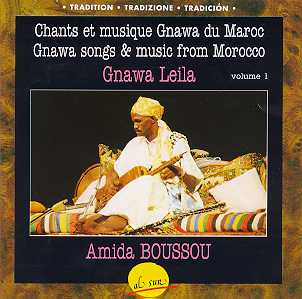 |
Volume I, Gnawa
Songs and Music from Morocco, includes examples of
music performed before the actual ceremony begins, as a
warm-up for both musicians and spectators. This disk is
really separate from the rest of the series, both in
terms of the structure of the ritual and, more important,
the circumstances of its recording. These examples were
collected three years before the rest of the "lila,"
in two separate places--Casablanca, the largest city in
Morocco, and Tamsloht, a village near Marrakech that is
the site of one of the Gnawa's most important annual
pilgrimages.  Sala' Nabi'na (180 kb
.wav file) Sala' Nabi'na (180 kb
.wav file)
|
| Volumes II-V were all
recorded in a single evening in Casablanca, although
Baldassarre does not specify whether the occasion was a lila
he happened to attend or a session specially
arranged for recording. Volume II begins with drumming,
known as l-A`ada, which is used to announce the
beginning of the ceremony. Here Baldassarre presents an
extended opening section in relatively slow, stately
tempo, and then, with a quick fade, jumps to the rapid
final phase of drumming. l-A`ada leads into the derdeba
proper, which begins with the White Suite, in honor
of the family of the Prophet.  l-A`ada (196 kb .wav file) l-A`ada (196 kb .wav file)
|
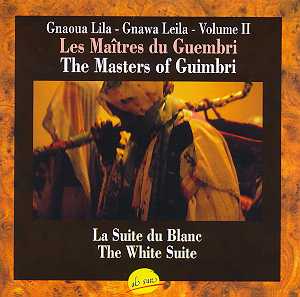 |
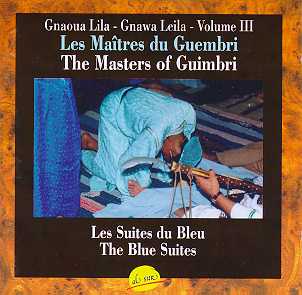 |
Volume III covers the
Blue suites, dedicated principally to Sidi Mousa, the
Lord of the Sea (dark blue), and Sidi Sma, the Lord of
the Sky (light blue). To the untutored listener, this
volume and the two that follow present more (or less) of
the same-- guimbri, qaraqeb, solo
voice, and chorus. And yet each has its own interest. For
example, the last two selections on this volume (Sidi Sma
and Allah Bou Yandi Samaoui) are among the most
compelling on the entire series, with a soaring chorus
beautifully balanced with the guimbri and solo
voice. Volume IV includes both the Red
and the Green suites which represent (ostensibly)
different aspects of the Gnawa belief system. After
invocations to the
|
| Prophet, the musicians sing for Sidi
Hammou, who presides over the Muslim Feast of Sacrifice,
and Baba Hammouda, the butcher who actually performs the
slaughter. (Hammouda's signature song, Band 5, was
adapted in the early seventies by the folk-pop group,
Nass el-Ghiwane.) Because of the connections to Muslim
sacrifice, Baldassarre associates this group with both
the Middle East and with surgical healing; some Gnawa in
Marrakech, on the other hand, regarded the Red spirits as
rather wild and fearsome. The Green Suite, in contrast,
is dedicated to the Shorfa (sing., Sherif), the noble
family of the Prophet Mohammed. Although the various
saints and spirits can be clearly distinguished by their
associated melodies and texts, the music for the
different families is quite similar in its general
stylistic features. |
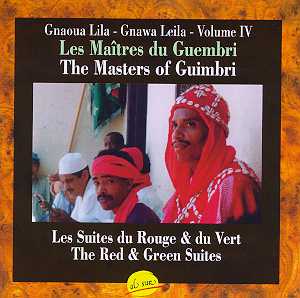  Hammouda (193 kb .wav file) Hammouda (193 kb .wav file)
|
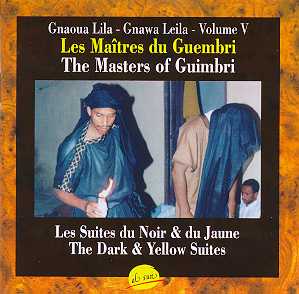 |
Finally, Volume V moves
further to the spirit side of the Gnawa, with the Black
and Yellow Suites. The Black Suite honors the ancestral
spirits of the forest, both male and female. The Yellow
Suite--which might actually be termed polychrome, since
it includes lavender, pink and other pastel colors--is
devoted entirely to female spirits, whose personalities
range from coquettish to terrifying. The set concludes
with a song in praise of Aisha Qandisha, a goat-footed
spirit who is revered, and feared, all over Morocco.  Aisha Qandisha (179 kb .wav file) Aisha Qandisha (179 kb .wav file)
|
Indeed, this last section provides final proof that the Gnawa
should not be called a "confraternity" or
"brotherhood," as many scholars, including Baldassarre,
persist in identifying them. While it is true that women rarely,
if ever, play instruments in Gnawa ceremonies, a large percentage
(perhaps even a majority) of the devotees are women, female
spirits figure prominently in the pantheon, and, most important,
many of the most respected officiants (mqaddem or mqaddema)
are women.
As Baldassarre himself points out at the beginning of his
notes, a recording satisfies only one of the senses, and can
therefore offer only a pale shadow of the experience of a live
performance by the Gnawa . The same could be said of any
recording, of course, but it is perhaps particularly crucial in
the case of the lila, which depends heavily on the
stimulation of all the senses, and equally important, on the
personal relations among the participants (and between the
participants and the spirits). Still, short of packaging these
disks along with seven colors of cloth, several varieties of
incense, and containers of dates and milk, it is hard to see how
Baldassarre cold have done a better job with the material at
hand.
The performances are superb. The two leaders, M'allem Sam
(Mohamed Zourhbat) and M'allem Hmidah (Ahmed Boussou), are
perhaps the most renowned Gnawa masters in Morocco. Age and
experience have given their voices and their playing a resonance
absent in many younger musicians, and they are both in fine form
here, as are the members of the chorus. The acoustic quality is,
in general, very good, although there are occasional flaws, as
one would expect in more than five hours of field recording. The
sound of the guimbri on Volume I is far louder,
relatively, than it would be in live performance, but listeners
uninterested in the text may actually prefer it that way. Volume
I also comes to an abrupt end, and the recordings from Tamesloht
are a bit disappointing. There are moments in the other volumes
when the sound is unbalanced, but overall, the disks are a
delight to listen to.
Baldassarre's notes in French and English include line
drawings of the instruments, bits of transcribed music, and a
great deal of useful information. The notes to Volume I reflect
the time gap between this disk and the rest of the series: the
contents are rather different; there are variant transliterations
of some terms and names (including M'allem Hmidah's); and there
are Arabic transcriptions of some of the texts (which would have
been welcome in the other volumes as well). The other four disks
all share the same background information, plus a short section
specific to each family of spirits, and translations of the
texts.
Each of these volumes can be purchased separately, and, aside
from passionate fans of the Gnawa and scholars specializing in
North Africa, it is unlikely that many people will want to buy
all five at once. Still, it is difficult to choose one above the
others. The laid-back, almost bluesy introductory sections
presented on Volume I may appeal to some listeners more than the
faster-paced ritual suites; in addition, the elimination of the qaraqeb
in the opening section, and their attenuation later on,
makes the guimbri and voice stand out more clearly. On
the other hand, Volume II, with the drumming selection and the
White Suite, offers the most variety of all the disks, while
Volume III offers some of the most stirring melodies--at least to
my ears. Similarly, feminists might be most interested in Volume
V, with its emphasis on female spirits, while bloody-minded macho
men might prefer Volume IV--or vice versa. So pick a disk, any
disk, to start with. The chances are that you will want to come
back for more.
Philip Schuyler
University of Maryland Baltimore County
pschuyle@umbc.edu
M&A
contents page




